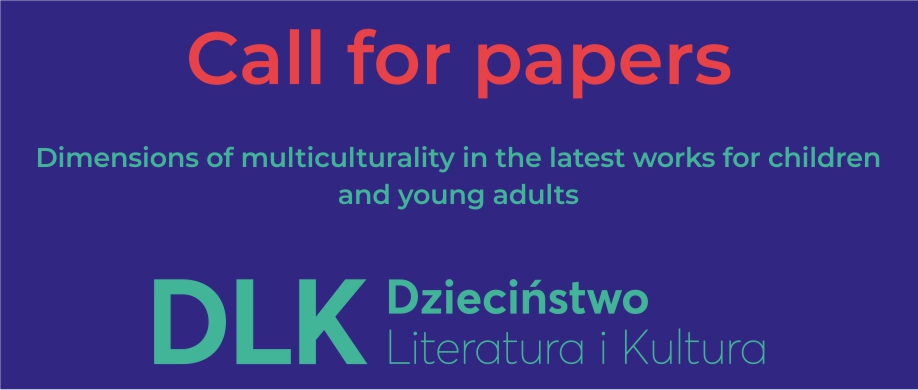Call for papers 1/2022

Dimensions of multiculturality in the latest works for children and young adults
The challenges of the 21st-century related to the nature and dynamics of diverse intercultural relations are becoming increasingly evident, both in Poland and in the world. They are reflected, among others, in various works for children and young adults. Literary works, films, television series, comic books, theatrical performances, or video games presenting issues of multiculturality have the potential to raise awareness of the importance of specific social problems, occurring both locally and on a global scale.
By inviting you to reflect on contemporary strategies for constructing images of multiculturality in various media targeted at children and young adults, we suggest it to be considered broadly. This category, which in research on works for young audiences includes mainly reflections on the relationships of ethnic and ‘racial’ groups, is nowadays increasingly often based on a capacious definition of culture. A decade ago, in 2011, Ambika Gopalakrishnan in the monograph Multicultural Children's Literature: A Critical Issues Approach stated that multicultural children’s literature draws from the social and cultural experiences of groups that were previously underrepresented, and its aim is to show the significance of these experiences, resulting from differences not only in ‘racial’ and ethnic origin, but also in gender, psychosexual identity, class, age, economic status, (dis)ability, etc. Earlier, in 2009, Maria José Botelho and Masha Kabakow Rudman in Critical Multicultural Analysis of Children's Literature: Mirrors, Windows, and Doors signalled that the category of ‘race’ cannot be viewed in isolation from the power relations resulting from class and gender inequalities, since any “cultural difference” is a historical and socio-political construct.
The category of multicultural children’s literature appeared as early as the 1960s, and research on it – which at that time focused mainly on ‘racial’ and ethnic diversity – began to develop rapidly in the last decade of the previous century. Mainly analysed was national literature, especially created in the USA, Canada, and Australia (Rudine Sims Bishop, John Stephens, Junko Yokota, and Hazel Rochman, and in the 21st century, for example, Sharyn Pearce and Miriam Verena Richter). Perhaps the most cited – so far – are monographs by Mingshui Cai (Multicultural Literature for Children and Young Adults: Reflections on Critical Issues from 2002) and by Botelho and Kabakow Rudman (cited above). Over time, scholarly works published in English ceased to concern only English-language literature, but began to take into consideration, for example, Spanish (the research of Macarena García-González), Greek (Meni Kanatsouli, Theodor Tzoka), Portuguese (Ana Margarida Ramos), Scandinavian (Ingeborg Kongslien), and Chinese (Chengcheng You) literature, as well as films and TV shows (Sharon Bramlett-Solomon and Yvette Roeder, Erynn Masi Casanova, Karen Wells). So far, only one monograph devoted (though not entirely) to literary studies of multicultural children’s and youth literature, edited by Bernardeta Niesporek-Szamburska and Małgorzata Wójcik-Dudek, has been published in Poland; in the book, individual authors analyse various aspects of literary images of cultural diversity, among others, from the perspective of translation studies, postcolonialism, gender studies and queer studies, as well as taking into consideration the goals of multicultural and intercultural education. Krystyna Kamińska (W stronę wielokulturowości w edukacji przedszkolnej, 2005) and Przemysław P. Grzybowski (among others: Edukacja europejska – od wielokulturowości ku międzykulturowości, 2009; Edukacja międzykulturowa – konteksty. Od tożsamości po język międzynarodowy, 2012; Inni, Obcy – ale Swoi. O edukacji międzykulturowej i wspólnocie w szkole integracyjnej, 2018 – work written with Grzegorz Idzikowski) devoted their monographs to the last issue. Polish researchers have also published a dozen or so scholarly articles – on multi- and interculturality understood as ethnic, national, and ‘racial’ diversity – from the perspective of literary studies (Katarzyna Smoter, Beata Gromadzka, Joanna Żygowska, Weronika Kostecka, Wójcik-Dudek, Krzysztof Rybak, Marta Jadwiga Pietrusińska, Ewelina Rąbkowska, Anna Fornalczyk-Lipska) and pedagogy (Lucyna Sadzikowska, Karolina Wawer, Anna Janus-Sitarz).
In the past two decades, works have also been published presenting the results of research on the texts for children and young adults that present constructions of: disability (in Poland – mainly by Alicja Fidowicz, and abroad – Tammy Berberi and Viktor Barberi, Tina Taylor Dyches and Mary Anne Prater, Zana Marie Luttfiya and Nancy Hansen, Debra L. Minarick, Martin F. Norden, and Patricia A. Dunn), non-heteronormativity and transgenderism (Dominik Borowski, Katarzyna Reszczyńska-Urban, Danielle Glassmeyer, Gwendolyn Limbach, Tison Pugh, Amanda Putnam, Michelle Ann Abate and Kenneth B. Kidd, Derritt Mason), gender (Grażyna Lasoń-Kochańska, Adrianna Zabrzewska, Gael Sweeney, Roberta Seelinger Trites, Tricia Clasen, and Holly Hassel), age (Vanessa Joosen).
Macarena García-González in the monograph Origin Narratives: The Stories We Tell Children About Immigration and International Adoptions (2017) rightly noticed that narratives not only reflect certain ideologies, but also constitute them. This is why we believe that it is important to carefully study the strategies used by authors of texts for children’s and young adult culture. Therefore, we invite you to submit scholarly articles on the following topics, taking into consideration the above-mentioned broad understanding of multiculturality:
- the ego-centric category of ‘otherness’ versus the equality-driven notion of diversity – ways of conceptualizing and presenting cultural differences in the 21st-century cultural texts for children and young adults;
- strategies for sensitizing young audiences to cultural diversity – by blurring or emphasising differences between specific groups, presenting various models of intercultural relations, creating an internal or external perspective of a multicultural community, etc.;
- ideological messages and methods of shaping the diegetic world in cultural texts – how do they show social reality? What do they enhance and what do they marginalise? Who do they give the voice to – and on what terms? What patterns of thinking do they reproduce and perpetuate, and which ones do they question and transform?
We also encourage you to send texts not related to the topic of the issue to the Varia and Review Articles sections.
Deadline for submitting articles: December 31, 2021





